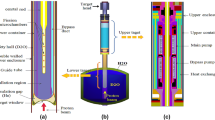Abstract
The study of accelerator-driven subcritical reactor systems (ADSs) has been an important research topic in the field of nuclear energy for years. The main code applied in ADS research is MCNPX, which was developed by Los Alamos National Laboratory. We studied the application of the open-source Monte Carlo codes FLUKA and OpenMC to a coupled ADS calculation. The FLUKA code was used to simulate the reaction of high-energy protons with the nucleus of the target material in the ADS, which produces spallation neutrons. Information on the spallation neutrons, such as their energy, position, direction, and weight, can be recorded by a user-defined routine called FLUSCW provided by FLUKA. Then, the information was stored in an external neutron source file in HDF5 format by using a conversion code, as required by the OpenMC calculation. Finally, the fixed-source calculation function of OpenMC was applied to simulate the transport of spallation neutrons and obtain the distribution of the neutron flux in the core region. In the coupled calculation, the high-energy cross-section library JENDL4.0/HE in ACE format produced by NJOY2016 was applied in the OpenMC transport simulation. The OECD–ADS benchmark problem was calculated, and the results were compared with those obtained using MCNPX. It was found that the flux calculations performed by FLUKA–OpenMC and MCNPX were in agreement, so the coupling calculation method for ADS is reasonable and feasible.









Similar content being viewed by others
References
N. Aizawa, F. Kubo, T. Iwasaki, Comparison of different neutronics analysis technique for accelerator-driven system. Ann. Nucl. Energy 60, 368–373 (2013). https://doi.org/10.1016/j.anucene.2013.05.019
W.L. Zhan, H.S. Xu, Advanced fission energy program—ADS transmutation system. Bull. Chin. Acad. Sci. 27, 375–383 (2012). https://doi.org/10.3969/j.issn.1000-3045.2012.03.017. (in Chinese)
D.B. Pelowitz (ed.), MCNPX User’s Manual, Version 2.7.0 (Los Alamos National Laboratory, New Mexico, 2011)
A. Krasa, Spallation Reaction Physics (2010), http://ojs.ujf.cas.cz/~krasa/ZNTT/SpallationReactions-text.pdf. Accessed 20 Jul 2017
K. Niita, H. Takada, S.I. Meigo et al., High-energy particle transport code NMTC/JAM. Nucl. Instrum. Methods B 184, 406–420 (2001). https://doi.org/10.1016/S0168-583X(01)00784-4
A. Ferrari, P.R. Sala, A. Fasso et al., FLUKA: a multi-particle transport code. Lancet 10(7740), 44–45 (2005). https://doi.org/10.2172/877507
S. Agostinelli, J. Amako, K. Amako et al., Geant4—a simulation toolkit. Nucl. Instrum. Methods A 506(3), 250–303 (2003). https://doi.org/10.1016/S0168-9002(03)01368-8
Y. Kadi, in Advanced Monte Carlo for Radiation Physics, Particle Transport Simulation and Applications, ed. by A. Kling, et al. (Springerg Berlin Heidelberg, New York, 2001), p. 1015
P. Neuhold, Influence of the FLUKA geometrical model on the ADS demonstration facility criticality calculations. Paper presented at Proceedings of the Monte Carlo 2000 Conference, Lisbo, Portugal, 23–26 October, 2000
T. Sasa, K. Tsujimoto, T. Takizuka et al., Code development for the design study of the OMEGA Program accelerator-driven transmutation systems. Nucl. Instrum. Methods A 463(3), 495–504 (2001). https://doi.org/10.1016/S0168-9002(01)00166-8
S. Zhou, H. Wu, L. Cao et al., LAVENDER: a steady-state core analysis code for design studies of accelerator driven subcritical reactors. Nucl. Eng. Des. 278, 434–444 (2014). https://doi.org/10.1016/j.nucengdes.2014.07.027
P.K. Romano, B. Forget, The OpenMC Monte Carlo particle transport code. Ann. Nucl. Energy 51, 274–281 (2013). https://doi.org/10.1016/j.anucene.2012.06.040
P.K. Romano, N.E. Horelik, B.R. Herman et al., OpenMC: a state-of-the-art Monte Carlo code for research and development. Ann. Nucl. Energy 82, 90–97 (2014). https://doi.org/10.1016/j.anucene.2014.07.048
The HDF Group, HDF5 User’s Guide, Release 1.10 (2015), https://support.hdfgroup.org/HDF5/doc/UG/HDF5__Users_Guide.pdf. Accessed 27 Jul 2017
A.C. Kahler (ed.), The NJOY Nuclear Data Processing System, Version 2016 (Los Alamos National Security, New Mexico, 2016)
A. Ferrari, P. R. Sala, A. Fasso et al, The FLUKA user routines: how to tailor FLUKA to specific user’s needs. Paper presented at 8th FLUKA Course, National Center of Scientific Research “Demokritos”, Athens, Greece, 30 March - 3 April 2009
X.Z. Li, H.C. Wu, Y.Q. Zheng et al., Development and application of high-energy nuclear data library for accelerator driven sub-critical system. Atom. Energy Sci. Technol. 49(Z1), 371–376 (2015). https://doi.org/10.7538/yzk.2015.49.s0.0371. (in Chinese)
S. Kunieda et al., Overview of JENDL-4.0/HE and benchmark calculation. Paper presented at Proceedings of the 2015 Symposium on Nuclear Data, Ibaraki Quantum Beam Research Center, Tokai-mura, Ibaraki, Japan, 19–20 November 2015
R.E. Macfarlane, A.C. Kahler, Methods for processing ENDF/B-VII with NJOY. Nucl. Data Sheets 111(12), 2739–2890 (2017). https://doi.org/10.1016/j.nds.2010.11.001
Organisation for Economic Co-operation and Development/Nuclear Energy Agency, Comparison Calculations for an Accelerator Driven Minor Actinide Burner (OECD, Paris, 2002)
B.C. Na, M. Cometto, P. Wydler et al., OECD/NEA comparison calculations for an accelerator-driven system using different nuclear data libraries. J. Nucl. Sci. Technol. 39(sup2), 835–840 (2002). https://doi.org/10.1080/00223131.2002.10875229
Author information
Authors and Affiliations
Corresponding author
Additional information
This work was supported by the “Strategic Priority Research Program” of the Chinese Academy of Sciences (No. XDA03030102).
Rights and permissions
About this article
Cite this article
Zhao, ZL., Yang, YW. & Hong, S. Application of FLUKA and OpenMC in coupled physics calculation of target and subcritical reactor for ADS. NUCL SCI TECH 30, 10 (2019). https://doi.org/10.1007/s41365-018-0539-1
Received:
Revised:
Accepted:
Published:
DOI: https://doi.org/10.1007/s41365-018-0539-1




